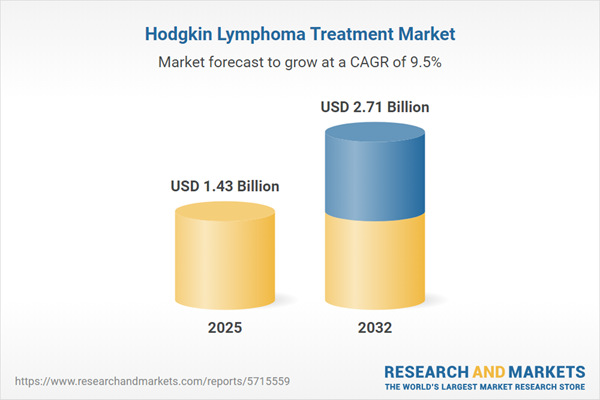Speak directly to the analyst to clarify any post sales queries you may have.
The Hodgkin Lymphoma Treatment Market is experiencing a period of accelerated innovation and strategic transformation, presenting significant opportunities for senior leaders to make informed, future-focused portfolio and operational decisions.
Market Snapshot: Hodgkin Lymphoma Treatment Market Expansion
The Hodgkin Lymphoma Treatment Market grew from USD 1.31 billion in 2024 to USD 1.43 billion in 2025. It is projected to continue expanding at a CAGR of 9.51%, reaching USD 2.71 billion by 2032. This robust trajectory is being propelled by advances in immunotherapy, targeted therapy, and molecular diagnostics, which are reshaping clinical management and driving new business models across regions. Senior decision-makers are increasingly required to adapt to this evolving landscape, characterized by shifting regulatory environments, pricing challenges, and a complex, multidisciplinary care ecosystem.
Scope & Segmentation
- Treatment Type: Chemotherapy (ABVD regimen, BEACOPP regimen, Liposomal formulations), Immunotherapy, Radiotherapy (Adaptive, Involved-Field, Proton), Targeted Therapy
- Disease Stage: Early stage (Stage I, Stage II), Advanced stage (Stage III, Stage IV)
- Treatment Line: First line, Second line, Third line
- Molecule Type: Monoclonal antibodies (CD30-directed antibodies: brentuximab vedotin, next generation antibodies; PD-1 inhibitors: nivolumab, pembrolizumab), Small molecules (Histone deacetylase inhibitors: next generation HDAC inhibitors, romidepsin, vorinostat)
- Patient Age: Adult, Geriatric, Pediatric
- Regions: Americas (United States, Canada, Mexico, Brazil, Argentina, Chile, Colombia, Peru), Europe, Middle East & Africa (United Kingdom, Germany, France, Russia, Italy, Spain, Netherlands, Sweden, Poland, Switzerland, United Arab Emirates, Saudi Arabia, Qatar, Turkey, Israel, South Africa, Nigeria, Egypt, Kenya), Asia-Pacific (China, India, Japan, Australia, South Korea, Indonesia, Thailand, Malaysia, Singapore, Taiwan)
- Key Companies: Takeda Pharmaceutical Company Limited, Bristol-Myers Squibb Company, Merck & Co., Inc., Gilead Sciences, Inc., Novartis AG, Roche Holding AG, Johnson & Johnson, Pfizer Inc., Seagen Inc., Kite Pharma, Inc.
Key Takeaways for Senior Decision-Makers
- Therapeutic advancements in immunology and molecularly targeted agents are significantly influencing protocol selection and patient outcomes.
- Segmentation by disease stage and patient age ensures tailored approaches, supporting optimization in toxicity management and supportive care across populations.
- Operational agility is increasingly vital as regulatory changes and regional disparities demand adaptable launch and pricing strategies.
- Collaborative industry initiatives, including R&D alliances and real-world data integration, are expediting translational benchmarks and informing evidence-driven strategies.
- Investments in digital pathology and AI are enabling precision medicine, supporting more individualized, data-driven treatment planning and relapse detection.
Tariff Impact: U.S. 2025 Tariffs and Supply Chain Dynamics
The introduction of United States tariffs in 2025 has prompted pharmaceutical and biotechnology firms to reassess global supply chains, impacting sourcing, production, and pricing. Tariffs on imported active pharmaceutical ingredients have led to realignment of supplier agreements and, in some cases, localization of key manufacturing steps. These adjustments have triggered ongoing negotiations with payers and healthcare providers regarding cost structures, heightened inventory management scrutiny, and closer collaborations with logistics partners. Proactive policy monitoring and agile supply chain planning are proving essential to manage disruptions and maintain consistent access to essential Hodgkin lymphoma therapies.
Methodology & Data Sources
This report is built on a comprehensive blend of primary interviews with clinical and policy leaders, together with extensive secondary research referencing peer-reviewed literature, regulatory documents, and proprietary industry databases. Analytical frameworks such as SWOT analysis and scenario planning were applied for validation, ensuring reliability of market insights and strategic recommendations.
Why This Report Matters
- Supports senior executives in understanding how evolving therapeutic pathways and regulatory shifts impact operational and portfolio strategies.
- Provides actionable intelligence for developing tailored market entry and pricing approaches aligned with nuanced regional and segment dynamics.
- Facilitates strategic investment in R&D, digital transformation, and supply chain resilience, helping organizations maintain competitiveness.
Conclusion
The Hodgkin Lymphoma Treatment Market is shaped by rapid scientific and regulatory evolution. Senior leaders who leverage this report's analytical depth can position their organizations to seize emerging opportunities, enhance patient outcomes, and sustain growth in a complex, global landscape.
Additional Product Information:
- Purchase of this report includes 1 year online access with quarterly updates.
- This report can be updated on request. Please contact our Customer Experience team using the Ask a Question widget on our website.
Table of Contents
3. Executive Summary
4. Market Overview
7. Cumulative Impact of Artificial Intelligence 2025
Companies Mentioned
The companies profiled in this Hodgkin Lymphoma Treatment market report include:- Takeda Pharmaceutical Company Limited
- Bristol-Myers Squibb Company
- Merck & Co., Inc.
- Gilead Sciences, Inc.
- Novartis AG
- Roche Holding AG
- Johnson & Johnson
- Pfizer Inc.
- Seagen Inc.
- Kite Pharma, Inc.
Table Information
| Report Attribute | Details |
|---|---|
| No. of Pages | 185 |
| Published | October 2025 |
| Forecast Period | 2025 - 2032 |
| Estimated Market Value ( USD | $ 1.43 Billion |
| Forecasted Market Value ( USD | $ 2.71 Billion |
| Compound Annual Growth Rate | 9.5% |
| Regions Covered | Global |
| No. of Companies Mentioned | 11 |









